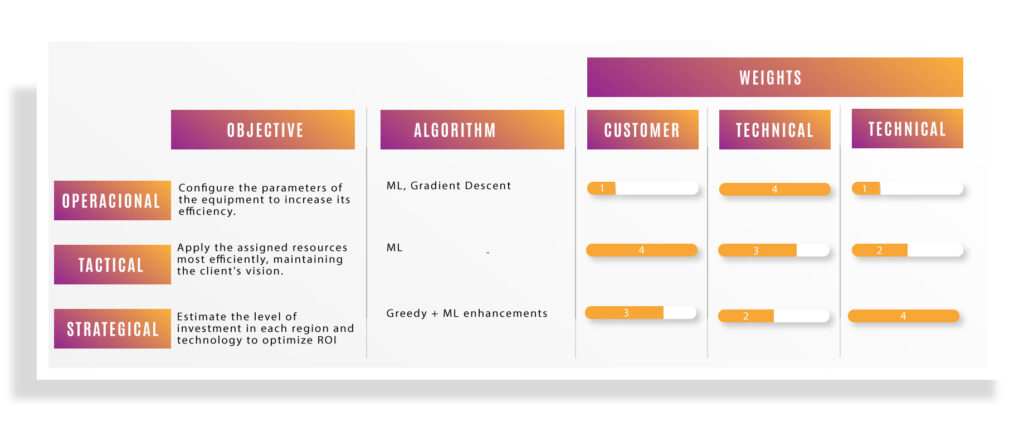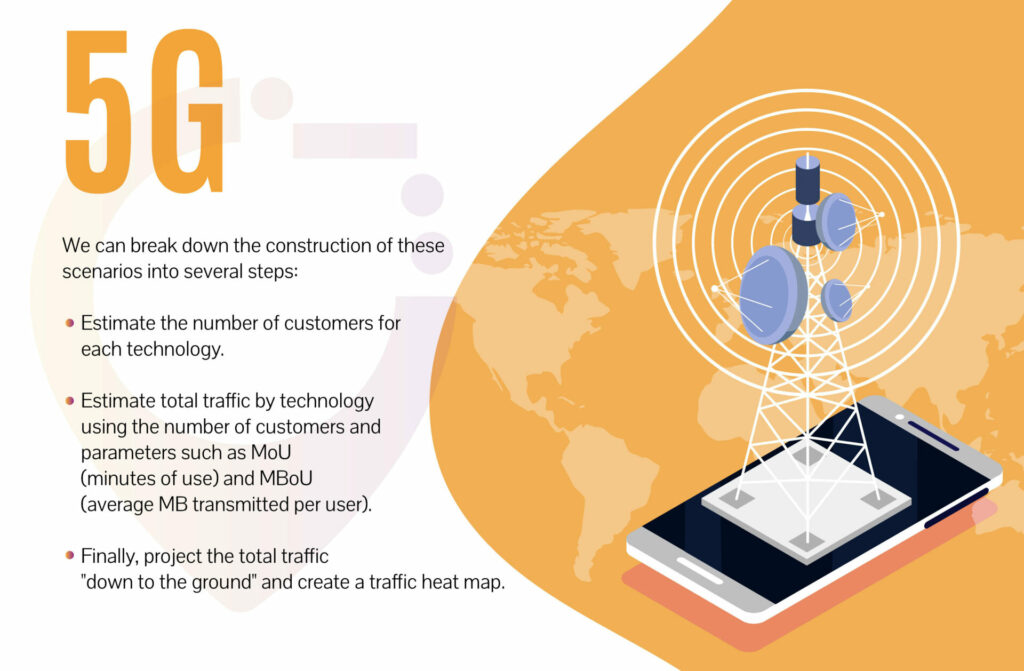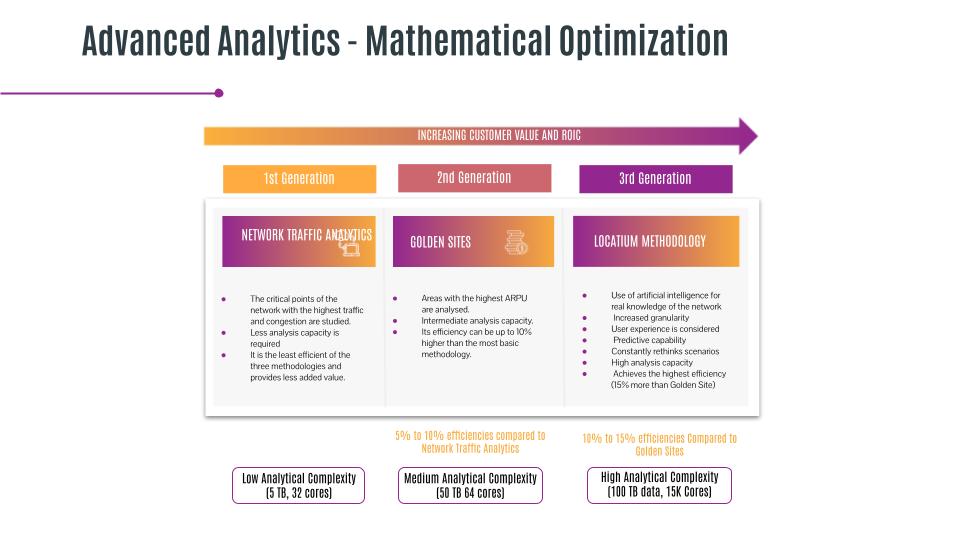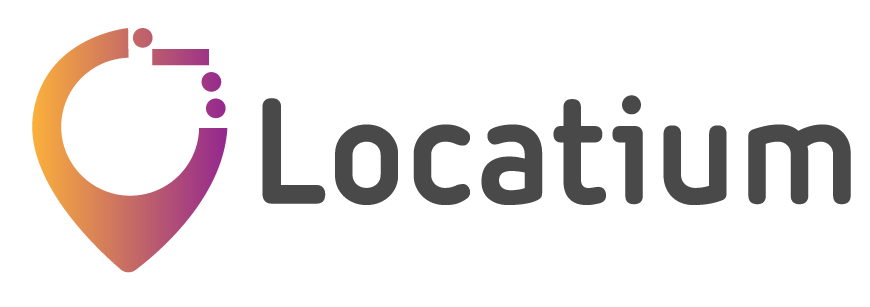Optimizing CAPEX when starting up a telecommunications network is one of the main recurring challenges faced by companies in the sector. Fortunately, this is easier to achieve through a model that combines the concerned data and the technology to extract value from it. In this article, we are going to show you how it is possible through 4 fundamental stages.
The cost structure of telecommunications mainly involves fixed costs. These include things like infrastructure deployment and acquisition. On the other hand, there is a very limited variable component related to traffic and consumption by customers who have been responsible for numerous price wars.
This cost structure, combined with the continuous technological evolution, and the growing use by users of data in new applications and outside the control of the operators, has made the planning of the network itself a complex task.
Throughout these years, we have contemplated three different strategic stages that impact both the network and business planning:
- The first stage focused on customer loyalty. Here, low network usage was considered the main limitation. During this stage, it was only enough to offer a good service with quality calls and mobile data even if it was in limited areas.
- As the appetite for telecommunications services increased, the objective changed to capturing fractional revenue from customers for specific services by embracing the multi-SIM phenomenon.
- Finally, when the clients and networks have reached a stage of maturity, the focus is to satisfy the user’s needs integrally. Or what is the same, we maintain all the income of the clients or we lose them.
The four steps of strategic network planning
Nowadays, the best network planning strategy goes through a set of 1+4 stages that we are going to describe below.
Previous step: be clear about what type of optimization we want
First of all, we must be clear that when we plan the optimization of a network, there are several options, which we can summarize in the following table:

1.- Understanding our customers
The first and most important step is to establish what our customers want, to know how relevant the user experience is to them, and plan the network to refine it until it meets their expectations.
Being customer-centric is fundamental, and many companies claim to be when they really have to go a long way to achieve this quality.
Here, the telecom company has to find answers to questions like: How clear is the link between user experience and customer retention? Can we link this to network KPIs? What about the user experience of competitors?
| Example: Analyzing the link between measured network quality and market shares in a market of more than 120M subscribers, we realize the operator that offers the best level of service has a much higher market share, but the differences in quality between the other tree operators do not reflect any difference in market share. We conclude that occasional increases in investment to improve quality will not generate an ROI, and it is preferable to increase coverage. The alternative would require an unaffordable investment effort given the uncertainty of a “quality war”. |
Based on all this, we can provide an objectively lower user experience in areas where our competitors are not as strong. Instead, we will need a much better one where these are more solidly established. Third-party data will be very useful here.
We need to establish the relationship between user experience and CAPEX, as well as market share/revenue region by region.
For doing it, we will first create a metric for the metric for the user experience. We will use network element KPIs, such as a proxy. We should also consider incorporating metrics like jitter, latency, and download speed.
Ultimately, what we most do is link user experience and customer acquisition and churn. Usually, this involves building a model that reflects the model’s behavior. Typically, the customer’s perception of service quality will be driven by their poor experiences, making average values of limited value here.

2.- Analysis of the future demand of the project
We need to prepare for the traffic that the network will support as it evolves, mainly through the migration of telephone lines and also from new use cases of technologies such as 5G. At the same time, we have to be able to quickly detect and react to changes in demand due to external causes.
The better we understand how it evolves, the better we can be prepared. The forecast of this evolution will be basing on two types of demand, one for which, thanks to the historical traffic record, we know with reasonable precision when and where it will occur, and another for which it will not, as they are new cases of use.
To address these new use cases, the analysis will most include the ability to handle indoor and outdoor demand.
To handle the uncertainty in new 5G use cases, for which we have no track record, we can turn to third-party reporting, multi-scenario, and consultant analysis.
We can break down the construction of these scenarios into several steps:
- Estimate the number of customers for each technology.
- Estimate total traffic by technology using the number of clients and parameters such as MoU (minutes of use) and MBoU (average MB transmitted per user).
- Finally, project the total traffic “down to the ground” and create a traffic heat map.
Ideally, this planning will not be limited to a single scenario, and there will be a periodic evaluation of it.

3.- Network modeling
Here, it’s important the generated model can redistribute the traffic between cells taking into account the range and overlap of these, offering a reasonably realistic model of the load distribution between different technologies. And, within each technology, between its frequencies.
To be more precise in network planning, we need to reflect network characteristics such as frequency balancing and fallback. To achieve this objective, it is convenient to define an algebra and a suitable DSL (Domain Specific Language) that can also improve the usability of the model and will allow the development of a test bench to compare different algorithms.
Therefore, this stage provides the basis for building the optimization algorithms. The first criterion is to simulate the impact on the network as accurately as possible, which implies evaluating aspects such as:
- The coverage must be a function of the frequency, the height of the antenna, and the terrain.
- Traffic is assigned to network elements taking into account coverage, frequency balance, and backup.
- Network element KPIs can be accurately estimated based on traffic allocation.
Simulating an action on the network has an impact that extends to multiple network elements. First, a new network element can “grab” traffic from other network elements in its vicinity, reducing its load.
This reduced load may in turn affect the frequency split for this technology and even remove the pressure to force a fallback to inferior technologies. This effect can spread to neighbors from neighbors…, like ripples in a pond when a stone is thrown.

4.- Improvement and algorithm
As we have indicated in table 1, for optimization at a strategic level, the reference algorithms will be variations of the greedy algorithms. This is because it is a combinatorial optimization problem with a large number of variables and with effects that are not local.
The algorithms used are similar to those used to play chess, a core that consists of a search between the different moves (greedy algorithm, MiniMax pruning) complemented by a Machine Learning layer that helps the main algorithm identify the most promising lines. In our particular board, we don’t have 16 pieces and 64 squares, but 2-3,000 pieces and 10-20,000 positions.
This type of mathematical optimization needs two elements:
- The algorithm itself, which can be a traditional graph search (breadth search or GRASP), a gradient descent type, or a Machine Learning one.
- The objective function, which must be aligned with the business objectives.
This is key to know how efficient the algorithm is in general circumstances and in those specific to our network. Also, you most know if you can adjust the objective function to reflect your business goals.
Different algorithms can be tested and compared to find the most effective one, using network action, which makes
- Different algorithms can find better solutions under different circumstances (refarming, capacity vs. coverage, etc.).
- The performance of algorithms can also differ, resulting in higher or lower computation costs.
The objective function would address the number or value of clients covered and depends on the final configuration.
In short, we can say that planning is based on a test bed that provides the basic mechanism for modeling the actions of the network. Historical data can be used to validate:
- The relationship between comparative network quality and market share.
- The minimum quality required to keep a customer.
- Phone migration trends and their impact.
- Impact of traffic load on network KPIs.
Finally, different algorithms could be implemented using the test platform to explore their effectiveness.
Data is, without a doubt, the central axis of the network strategy. At Locatium, we have what you need and the most appropriate technology to define the one that will offer you the best results. Do you want to know how? Contact us.






